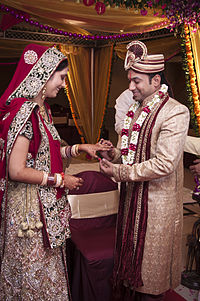family structure and marraige in india
For generations, India has a prevailing tradition of the joint family system. It is when extended members of a family – parents, children, the children's spouses and their offspring, etc. – live together. Usually, the oldest male member is the head in the joint Indian family system. He mostly makes all important decisions and rules, and other family members are likely to abide by them.
In a 1966 study, Orenstein and Micklin analysed India's population data and family structure. Their studies suggest that Indian household sizes had remained similar over the 1911 to 1951 period. There after, with urbanisation and economic development, India has witnessed a break up of traditional joint family into more nuclear-like families. Sinha, in his book, after summarising the numerous sociological studies done on Indian family, notes that over the last 65 years, the cultural trend in most parts of India has been an accelerated change from joint family to nuclear families, much like population trends in other parts of the world. The traditional large joint family in India, in the 1990s, accounted for a small percent of Indian households, and on average had lower per capita household income. He finds that joint family still persists in some areas and in certain conditions, in part due cultural traditions and in part due to practical factors. Youth in lower socio-economic classes are more inclined to spend time with their families than their peers due to differing ideologies in rural and urban parenting. With the spread of education and growth of economics, the traditional joint-family system is breaking down rapidly across India and attitudes towards working women have changed.
Brides in India
Shy smile of a bride in a Hindu Indian wedding.

Indian bride on her wedding day.
Arranged marriages have long been the norm in Indian society. Even today, the majority of Indians have their marriages planned by their parents and other respected family-members. In the past, the age of marriage was young. The average age of marriage for women in India has increased to 21 years, according to 2011 Census of India. In 2009, about 7% of women got married before the age of 18.
In most of the marriages the bride's family provide a dowry to the bridegroom. Traditionally, the dowry was considered a woman's share of the family wealth, since a daughter had no legal claim on her natal family's real estate. It also typically included portable valuables such as jewellery and household goods that a bride could control throughout her life. Historically, in most families the inheritance of family estates passed down the male line. Since 1956, Indian laws treat males and females as equal in matters of inheritance without a legal will. Indians are increasingly using a legal will for inheritance and property succession, with about 20 percent using a legal will by 2004.
In India, the divorce rate is low — 1% compared with about 45% in the United States. These statistics do not reflect a complete picture, though. There is a dearth of scientific surveys or studies on Indian marriages where the perspectives of both husbands and wives were solicited in-depth. Sample surveys suggest the issues with marriages in India are similar to trends observed elsewhere in the world. The divorce rates are rising in India. Urban divorce rates are much higher. Women initiate about 80 percent of divorces in India.
Opinion is divided over what the phenomenon means: for traditionalists the rising numbers portend the breakdown of society while, for some modernists, they speak of a healthy new empowerment for women.
healthy new empowerment for women.
Recent studies suggest that Indian culture is trending away from traditional arranged marriages. Banerjee et al. surveyed 41,554 households across 33 states and union territories in India in 2005. They find that the marriage trends in India are similar to trends observed over last 40 years in China, Japan and other nations. The study found that fewer marriages are purely arranged without consent and that the majority of surveyed Indian marriages are arranged with consent. The percentage of self-arranged marriages (called love marriages in India) were also increasing, particularly in the urban parts of India
Thanks for sharing this. I have friend who just got married to an Indian citizen. I'm happy for her as she's been waiting for the right person to come. I'm a witness of her journey and now she's happily married.
that's why we love india(because of his culture)